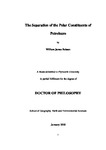The Separation of the Polar Constituents of Petroleum
| dc.contributor.supervisor | Rowland, Steven | |
| dc.contributor.author | Robson, William | |
| dc.contributor.other | School of Geography, Earth and Environmental Sciences | en_US |
| dc.date.accessioned | 2018-09-04T15:39:52Z | |
| dc.date.issued | 2018 | |
| dc.date.issued | 2018 | |
| dc.identifier | 10253054 | en_US |
| dc.identifier.uri | http://hdl.handle.net/10026.1/12226 | |
| dc.description.abstract |
Identification of the heteroatom (nitrogen, sulphur, and oxygen; NSO)-containing compounds of petroleum is of key importance when considering industrial and environmental issues associated with crude oil production. The inherent molecular complexity of petroleum is such that detailed compositional investigations must ideally be preceded by some form of pre-fractionation. However, the more commonly performed methods of crude oil fractionation are often insufficient in the extent to which they separate oils, not allowing defined “molecular” fractions to be obtained and thus hindering more detailed investigations. The following work therefore focused on the development of chromatographic methods to aid in the characterisation of NSO compounds present within crude oils. A novel solid phase extraction (SPE) procedure was developed utilising both ion exchange and adsorption chromatography. The method enabled fractions broadly defined as ‘saturated’ hydrocarbons; ‘aromatic’ hydrocarbons; basic nitrogen compounds; naphthenic acids; phenols and other oxygen-containing species; carbazoles; sulfoxides; and thiophenes, to be isolated reproducibly and quantitatively from relatively small crude oil samples (~ 0.5 g). Assessment of method selectivity with a suite of ‘model’ compounds showed that the resulting fractions were quite well defined, with classes of ‘model’ compounds being isolated within discrete fractions. Application to five crude oils of widely varying properties and origins, such as API gravity (12.1−38.3°), demonstrated the potential for the wide-ranging use of the method. Sample recoveries were high (77−98%) with simple evaporative losses accounting for the majority of sample loss. Repeatability was also high, demonstrated by triplicate analyses of ‘model’ compound mixtures, oils spiked with ‘model’ compounds and oils alone. Subsequent, more detailed, analysis of the fractions using multidimensional gas chromatography-mass spectrometry (GC×GC-MS) and liquid chromatography-highresolution accurate mass-mass spectrometry (LC-HRAM-MS) showed the advantages of the new isolation method. For example, alkylated series (C1-5) of quinolines, carbazoles, fluorenones, dibenzothiophenes and xanthones were identified within their predicted fractions. Furthermore, comparison of mass spectra obtained from GC×GC-MS analyses with reference spectra resulted in the tentative identification of compounds hitherto not previously reported in crude oils, again illustrating the advantage of the isolation method. Novel series of thioxanthones, tocopherols (E vitamins) and terpenoidal sulfoxides and ketones were assigned within the isolated fractions. Following the successful evaluation of the method, the scheme was subsequently employed to investigate the effects of changing geochemical parameters on the composition of isolated NSO-containing compounds. For example, studies of NSO fractions from series of crude oils at different stages of thermal maturity or of biodegradation, led to the identification of a number of potential new molecular markers within the basic-nitrogen and ketone fractions. This work shows clear potential for the developed NSO isolation method to be used in further compositional studies as a tool to aid in geochemical investigations. | en_US |
| dc.description.sponsorship | Kernow Analytical Technologies Ltd. | en_US |
| dc.language.iso | en | |
| dc.publisher | University of Plymouth | |
| dc.subject | Geochemistry | en_US |
| dc.subject | Petrochemistry | en_US |
| dc.subject | Analytical Chemistry | en_US |
| dc.subject.classification | PhD | en_US |
| dc.title | The Separation of the Polar Constituents of Petroleum | en_US |
| dc.type | Thesis | |
| plymouth.version | publishable | en_US |
| dc.identifier.doi | http://dx.doi.org/10.24382/1162 | |
| dc.identifier.doi | http://dx.doi.org/10.24382/1162 | |
| dc.rights.embargodate | 26/07/2019 | |
| dc.rights.embargoperiod | 12 months | en_US |
| dc.type.qualification | Doctorate | en_US |
| rioxxterms.version | NA | |
| atmire.cua.enabled | ||
| plymouth.orcid.id | https://orcid.org/0000-0002-7837-047X | en_US |
Files in this item
This item appears in the following Collection(s)
-
01 Research Theses Main Collection
Research Theses Main


